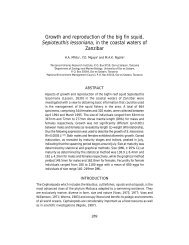UNEP Projects in Senegal - GRID Africa GeoPortal - UNEP
UNEP Projects in Senegal - GRID Africa GeoPortal - UNEP
UNEP Projects in Senegal - GRID Africa GeoPortal - UNEP
You also want an ePaper? Increase the reach of your titles
YUMPU automatically turns print PDFs into web optimized ePapers that Google loves.
<strong>UNEP</strong> <strong>Projects</strong> <strong>in</strong> <strong>Senegal</strong>DGEF supported projectsS<strong>in</strong>gle Country <strong>Projects</strong>Country Project Name Region Focal Area Agency Project TypeGEF Grant(US$M)ProjectStage<strong>Senegal</strong>National Adaptation ProgramClimateEnabl<strong>in</strong>gAFR <strong>UNEP</strong> 0.195 CEOof Action Change Activity Approved<strong>Senegal</strong>Enabl<strong>in</strong>g activities for theStockholm Convention onPersistent Organic Pollutants:National Implementation Planfor <strong>Senegal</strong>AFRPersistentOrganicPollutants(POPs)<strong>UNEP</strong>Enabl<strong>in</strong>g0.495 CEOActivity ApprovedRegional and Global <strong>Projects</strong>Country Project Name Region Focal Area Agency Project TypeGEF Grant(US$M)ProjectStageRegionalDemonstration of a RegionalApproach to EnvironmentallySound Management of PCBLiquid Wastes andTransformers and CapacitorsConta<strong>in</strong><strong>in</strong>g PCBsAFRPersistentOrganicPollutants(POPs)<strong>UNEP</strong>Full SizeProject6.000 Pipel<strong>in</strong>eRegionalBuild<strong>in</strong>g Scientific andTechnical Capacity forEffective Management andSusta<strong>in</strong>able Use of DrylandBiodiversity <strong>in</strong> West <strong>Africa</strong>nBiosphere ReservesAFR Biodiversity <strong>UNEP</strong>Full SizeProject2.750 CEOEndorsedRegionalReduc<strong>in</strong>g Dependence onPOPs and other Agro-Chemicals <strong>in</strong> the <strong>Senegal</strong> andNiger River Bas<strong>in</strong>s throughIntegrated Production, Pestand Pollution ManagementAFRPersistentOrganicPollutants(POPs)<strong>UNEP</strong>Full Size4.478 CouncilProject ApprovedRegionalRegionalRegionalDesert Marg<strong>in</strong>s ProgrammeFull SizeAFR Biodiversity <strong>UNEP</strong> 5.366 Pipel<strong>in</strong>e(DMP) Phase 3 ProjectDesert Marg<strong>in</strong>s ProgrammeFull SizeAFR Biodiversity <strong>UNEP</strong> 5.617 CEO(DMP) Tranche 2 Project EndorsedDesert Marg<strong>in</strong> Programme,Full SizeAFR Biodiversity <strong>UNEP</strong> 5.352 CEOPhase 1 Project EndorsedRegionalProtection of the CanaryCurrent Large Mar<strong>in</strong>eEcosystem (LME)AFRInternationalFull Size<strong>UNEP</strong> 5.340 PDF BWaters ProjectRegionalEnhanc<strong>in</strong>g Conservation of theCritical Network of Sites ofWetlands Required byMigratory Waterbirds on the<strong>Africa</strong>n/Eurasian Flyways.REG Biodiversity <strong>UNEP</strong>Full SizeProject6.350 CEOEndorsed
RegionalFouta Djallon HighlandsIntegrated Natural ResourcesManagement Project (FDH-INRM) (Tranches 1 and 2)AFRLandFull Size<strong>UNEP</strong> 11.554 CouncilDegradation Project ApprovedRegionalReduction of EnvironmentalImpact from Coastal Tourismthrough Introduction of PolicyChanges and Strengthen<strong>in</strong>gPublic-Private PartnershipsAFRInternationalFull Size<strong>UNEP</strong> 6.000 PDF BWaters ProjectGlobalPromot<strong>in</strong>g Best Practices forConservation and Susta<strong>in</strong>ableUse of Biodiversity of GlobalSignificance <strong>in</strong> Arid and SemiaridZonesCEX Biodiversity <strong>UNEP</strong>Medium SizeProject0.750 CEOApprovedGlobalCountry Case Studies onSources and S<strong>in</strong>ks ofGreenhouse GasesCEXClimateChange<strong>UNEP</strong>Enabl<strong>in</strong>gActivity4.700 CouncilApprovedDetails of the DGEF Supported projectsBuild<strong>in</strong>g Scientific and Technical Capacity for Effective Management and Susta<strong>in</strong>able Use ofDryland Biodiversity <strong>in</strong> West <strong>Africa</strong>n Biosphere Reserves-• 1 June to 28 May 2007• Objective: "The goal of the project is to conserve and susta<strong>in</strong>ably use biodiversity <strong>in</strong> six biospherereserves <strong>in</strong> West <strong>Africa</strong>, by strengthen<strong>in</strong>g scientific and technical capacity for effective reservemanagement. This targeted <strong>in</strong>tervention will complement exist<strong>in</strong>g <strong>in</strong>vestments and projects with<strong>in</strong> thereserves. The project will improve understand<strong>in</strong>g of <strong>in</strong>teractions between local communities andsavanna ecosystems, identify and promote susta<strong>in</strong>able use of biodiversity <strong>in</strong> pilot demonstrations,strengthen stakeholder capacity at all levels, and more effectively <strong>in</strong>tegrate stakeholders <strong>in</strong>to themanagement of each biosphere reserve. The project will make use of the <strong>Africa</strong>n Network of BiosphereReserves, AfriMAB, and, <strong>in</strong> particular, the sub-regional AfriMAB network for West <strong>Africa</strong> fortechnical and scientific <strong>in</strong>formation exchange, capacity build<strong>in</strong>g, and shar<strong>in</strong>g of lessons learned."Countries: Ben<strong>in</strong>, Burk<strong>in</strong>a Faso, Mali, Somalia, Niger, Nigeria, <strong>Senegal</strong>Enabl<strong>in</strong>g activities to facilitate the preparation of a National Adaptation Plan of Action (NAPAs) for<strong>Senegal</strong>• 1 November 2003 to February 2005• The project will support preparation of a national adaptation program of action (NAPA) to addressurgent and immediate needs and concerns related to adaptation to the adverse effects of climate change.Desert Marg<strong>in</strong>s Programme (DMP)-• 1 January to 1 January 2008• Objectives : Develop a better understand<strong>in</strong>g of the causes, extent, severity and physical processes ofland degradation <strong>in</strong> traditional crop, tree, and livestock production systems <strong>in</strong> the desert marg<strong>in</strong>s, andthe impact, relative importance, and relationship between natural and human factors; Document andevaluate current <strong>in</strong>digenous soil, water, nutrient, vegetation, and livestock management practices forarrest<strong>in</strong>g land degradation and to identify socio-economic constra<strong>in</strong>ts to the adoption of improvedmanagement practices; Develop and foster improved and <strong>in</strong>tegrated soil, water, nutrient, vegetation, and
livestock management technologies and policies to achieve greater productivity of crops, trees, andanimals to enhance food security, <strong>in</strong>come generation, and ecosystem resilience <strong>in</strong> the desert marg<strong>in</strong>s;Evaluate the impact and assist <strong>in</strong> design<strong>in</strong>g policies, programs, and <strong>in</strong>stitutional options that <strong>in</strong>fluencethe <strong>in</strong>centives for farmers and communities to adopt improved resource management practices; Promotemore efficient drought-management policies and strategies; Enhance the <strong>in</strong>stitutional capacity ofcountries participat<strong>in</strong>g <strong>in</strong> the DMP to undertake land degradation research and the extension ofimproved technologies, with particular regard to multidiscipl<strong>in</strong>ary and participative socio-economicresearch; Facilitate the exchange of technologies and <strong>in</strong>formation among farmers, communities,scientists, development practitioners, and policymakers.• Executive Summary: The Desert Marg<strong>in</strong>s Programme (DMP) is a collaborative venture among multilayerpartners from n<strong>in</strong>e <strong>Africa</strong>n countries: Burk<strong>in</strong>a Faso, Botswana, Mali, Namibia, Niger, <strong>Senegal</strong>,Kenya, South <strong>Africa</strong>, and Zimbabwe to <strong>in</strong>tegrate different discipl<strong>in</strong>es and comb<strong>in</strong>e of farmers/resourceusers’ contemporary knowledge, research and development efforts for arrest<strong>in</strong>g and revers<strong>in</strong>g landdegradation. The programme execution is coord<strong>in</strong>ated by ICRISAT. DMP was developed <strong>in</strong> response toa recommendation made to the <strong>in</strong>ternational research community at UNCED to consider specificcontributions for implementation of the three International Conventions on Biodiversity, ClimateChange, and Desertification. The goal of DMP is to contribute to susta<strong>in</strong>able food security and povertyalleviation through activities that conserve and restore biodiversity and reverse degradation processes <strong>in</strong>managed landscapes. The overall objective of DMP is to promote <strong>in</strong>novative and action-orienteddryland management research to arrest land degradation <strong>in</strong> <strong>Africa</strong>’s desert marg<strong>in</strong>s throughdemonstration and capacity build<strong>in</strong>g activities. DMP is envisaged to contribute significantly to reduc<strong>in</strong>gland degradation <strong>in</strong> the marg<strong>in</strong>al areas and help conserve biodiversity, and at the same time providealternative livelihoods to the rural communities.• Outcome: Sub-regional, National and local capacity build<strong>in</strong>g Emphasis will be placed on: -re<strong>in</strong>forcement of national capacities to carefully monitor climate, soil, vegetation and livestock trendsand dynamics; - standardization of methodologies to ensure data quality; - build<strong>in</strong>g effectivepartnership of national (NGOs, rural communities, CBOs), regional and <strong>in</strong>ternational <strong>in</strong>stitutions tocreate a cont<strong>in</strong>uum from identification, test<strong>in</strong>g to extension and adoption of technologies for arrest<strong>in</strong>gbiodiversity loss and promot<strong>in</strong>g its susta<strong>in</strong>able use - build<strong>in</strong>g capacity of stakeholders <strong>in</strong> land useplann<strong>in</strong>g. The GEF <strong>in</strong>crement will enhance stakeholders’ awareness and skills <strong>in</strong> natural resourcemanagement and strengthen community <strong>in</strong>volvement <strong>in</strong> natural resource management lead<strong>in</strong>g to moreeffective biodiversity conservation and reduction <strong>in</strong> natural resource degradation.Biodiversity Conservation through Participatory Rehabilitation of Degraded Lands of Arid & Semi-Arid Transboundary Areas of Mauritania & <strong>Senegal</strong>• 1 September 2001 to 28 October 2005• Objective: "The project addresses the root causes of biodiversity loss from land degradation <strong>in</strong> the fivecritical, upland and floodpla<strong>in</strong> ecosystems of a 60,000 km2 portion of the trans-border <strong>Senegal</strong> RiverValley <strong>in</strong> <strong>Senegal</strong> and Mauritania. The project will improve on techniques for rehabilitat<strong>in</strong>g the naturalecosystems of these degraded lands. It will develop and apply participatory resource managementsystems, especially those that generate resource-based <strong>in</strong>come and consequent economic <strong>in</strong>centives forsusta<strong>in</strong>able management. Fire prevention and suppression of fire-sensitive ecosystems will bestrengthened. Measures to decrease pressures on the forest and range resources will be undertaken.Ecosystem restoration and improved fire control will have the double benefit of enhanc<strong>in</strong>g carbons<strong>in</strong>ks. Institutional capacity will be strengthened at all levels from the village to the cross-national."Countries: Mauritania, <strong>Senegal</strong>Other <strong>UNEP</strong> projects <strong>in</strong>clude:
Partnership for the Development of Environmental Laws and Institutions <strong>in</strong> <strong>Africa</strong> (PADELIA) –Phase II• 1 January 2001 to 1 December 2006• Objective: To enhance the capacity of <strong>Africa</strong>n countries for the development, implementation andenforcement of environmental law and related <strong>in</strong>stitutions.Executive Summary: The project aims to support and promote enhancement of capacities of <strong>Africa</strong>ncountries for the development and strengthen<strong>in</strong>g of environmental law and correspond<strong>in</strong>g national andregional <strong>in</strong>stitutions to ensure effective enforcement of laws for alleviat<strong>in</strong>g poverty <strong>in</strong> the cont<strong>in</strong>ent.Outcome: A new culture of environmental legislative process established with its core components ofconsensus build<strong>in</strong>g and national ownership. 2. New expertise <strong>in</strong> environmental law created throughawareness rais<strong>in</strong>g, and tra<strong>in</strong><strong>in</strong>g workshops 3. A number of draft national and regional environmentalrelated laws developed, harmonized and adopted by Parliaments. 4. A number of lawyers, judges,magistrates, legal practitioners and law enforcement officers tra<strong>in</strong>ed to play a better role <strong>in</strong> theimplementation and enforcement of environmental law. 5. Legal materials on environmental lawdeveloped and published. Texts of environmental law and judicial decisions <strong>in</strong> the project's publicationsare on demand worldwide.Countries: Burk<strong>in</strong>a Faso, Malawi, Mozambique, Sao Tome and Pr<strong>in</strong>cipe, Kenya, United Republic ofTanzania, Uganda, Mali, <strong>Senegal</strong>, NigeriaProject Pr<strong>in</strong>cipal Division: Division of Policy Development and Law.Implement<strong>in</strong>g Divisions / Offices: UNDP United Nations Development Programme (Partner)<strong>Africa</strong> Environment Information Network (AEIN) - Phase I-• 1 January 2003- 1 August 2005.• Objective: A central objective of AEIN is to build capacity for establish<strong>in</strong>g the essential datafoundation and <strong>in</strong>formation management framework needed to support country-level <strong>in</strong>tegratedenvironmental assessment and report<strong>in</strong>g, with<strong>in</strong> the broad framework of susta<strong>in</strong>able development goalsand <strong>in</strong>itiatives. A specific short-term objective is to support the implementation of decisions of the<strong>Africa</strong>n M<strong>in</strong>isterial Conference on the Environment (AMCEN) with respect to the AEO preparationprocess, while strengthen<strong>in</strong>g capacity for environment assessment and report<strong>in</strong>g at the national and subregionallevels.• Executive Summary: The goal of AEIN is to enhance accessibility to more reliable environmental dataand <strong>in</strong>formation at national level for the environmental assessment and report<strong>in</strong>g <strong>in</strong> the region. Thestrategy <strong>in</strong>volves facilitat<strong>in</strong>g greater network<strong>in</strong>g among national <strong>in</strong>stitutions and others at sub-regionaland regional levels as well as build<strong>in</strong>g their capacity where such needs exist. The network aims topromote cooperation and partnerships <strong>in</strong> environmental data and <strong>in</strong>formation shar<strong>in</strong>g, and is less aboutequipment even though this is an essential component. AEIN is be<strong>in</strong>g implemented to “build capacityfor <strong>in</strong>tegrated environmental assessments and report<strong>in</strong>g” <strong>in</strong> <strong>Africa</strong>.Outcome: The AEIN <strong>in</strong>itiative has been used to <strong>in</strong>form stakeholders (policy makers/decision makers,collaborat<strong>in</strong>g <strong>in</strong>stitutions) from the 12 pilot phase countries and at sub-regional level of the need togenerate and share policy relevant environmental data and <strong>in</strong>formation, which can be used for policydevelopment, capacity build<strong>in</strong>g, etc. - The project has enabled the 12 AEIN pilot phase countries assessnational capacity build<strong>in</strong>g needs, <strong>in</strong>clud<strong>in</strong>g status of Environmental Information Systems (EIS), dataavailability/gaps as well as test environmental assessment and report<strong>in</strong>g tools that have been developedby <strong>UNEP</strong>. The project has been used to undertake national and sub-regional <strong>in</strong>tegrated environmentalassessment and report<strong>in</strong>g, based on development goals such as New Partnerships for <strong>Africa</strong>’sDevelopment (NEPAD), PRSPs, etc. Experts and <strong>in</strong>stitutions at national, sub-regional and regionallevels have been identified and have been actively <strong>in</strong>volved <strong>in</strong> national, sub-regional, regional (AEO-2)
and global (GEO-4) environmental assessment and report<strong>in</strong>g processes. - Structure, thematic areas,major environmental issues for the AEO-2 report has been developed and a draft report prepared.Countries: Egypt, Ethiopia, Gabon, Lesotho, Mauritius, <strong>Senegal</strong>, Seychelles, Tunisia, Uganda, ZambiaDevelopment of National Legal Databases for Capacity-Build<strong>in</strong>g to Enhance Access to EnvironmentLaw Information <strong>in</strong> <strong>Africa</strong>-• 1 September 2004 to 1 September 2007.• Objective: To develop national capacities and provide technical support to selected <strong>Africa</strong>n countriesfor development of national databases of environmental law.Executive Summary: The project is designed to develop web-based national legal databases ofenvironmental legislation, regulations and <strong>in</strong>stitutions for environmental management, activities andevents, state of environment reports, the country’s status of <strong>in</strong>ternational legal <strong>in</strong>struments, planspolicies and programs relat<strong>in</strong>g to environment, reports and publications. The project plans to buildcapacity through tra<strong>in</strong><strong>in</strong>g programmes on the development of databases and organiz<strong>in</strong>g environmentallaw <strong>in</strong>formation <strong>in</strong> a user-friendly way.Outcome: Enhanced accessibility of environmental law <strong>in</strong>formation through web-based database togovernment officials, judiciary, legal practitioners, academia, civil society and the general public toaccess environmental law <strong>in</strong>formation. This will <strong>in</strong>crease utilization of national environmental laws,improv<strong>in</strong>g environmental law decision mak<strong>in</strong>g, compliance and enforcement and assist<strong>in</strong>g <strong>in</strong>environmental management. Capacity-build<strong>in</strong>g tra<strong>in</strong><strong>in</strong>g programmes will tra<strong>in</strong> legal experts to collect,organize, process and retrieve environmental law <strong>in</strong>formation on the national website database.Countries: Burk<strong>in</strong>a Faso, Cameroon, Central <strong>Africa</strong>n Republic, Chad, Côte d'Ivoire, Congo, Djibouti,Gabon, <strong>Senegal</strong>, Mali, Botswana, Ghana, Kenya, Lesotho, Malawi, Mauritius, Mozambique, Nigeria,South <strong>Africa</strong>, United Republic of TanzaniaProject Pr<strong>in</strong>cipal Division: Division of Policy Development and Law. Implement<strong>in</strong>g Organizations:FAO (Partner), IUCN (Partner)An Ecosystem Approach to Restor<strong>in</strong>g West <strong>Africa</strong>n Drylands and Improv<strong>in</strong>g Rural Livelihoodsthrough Agroforestry-based Land Management Interventions• 1 November 2004 to 1 October 2007.• Objective: To restore degraded West <strong>Africa</strong>n ecosystems and improve rural livelihoods. throughbuild<strong>in</strong>g regional, national and local capacities <strong>in</strong> new scientific advances and tools for (1) diagnosisof land degradation problems and target<strong>in</strong>g of <strong>in</strong>terventions, (2) valuation of ecosystem services and<strong>in</strong>tegrated evaluation of policies for susta<strong>in</strong>able land management, and (3) conservation agroforestrypractices and adaptive ecosystem management.• Executive Summary: The project aims to promote an ecosystems approach for susta<strong>in</strong>ablemanagement of the Parkland ecosystems (<strong>in</strong>tegrated crop-tree-livestock systems) of the semi-aridlowlands of West <strong>Africa</strong>. The project will build regional and local capacity <strong>in</strong> environmental policydevelopment for restor<strong>in</strong>g the West <strong>Africa</strong>n Parklands with the ultimate aim of improv<strong>in</strong>g humanwell-be<strong>in</strong>g and alleviat<strong>in</strong>g poverty. The project will complement <strong>UNEP</strong>’s support for theimplementation of the UNCCD, by aim<strong>in</strong>g to restore degraded drylands <strong>in</strong> <strong>Africa</strong>, prevent furtherdesertification and promote susta<strong>in</strong>able land management as an <strong>in</strong>tegral part of national developmentpolicies, strategies and plans.• Outcome: Improved rural livelihoods through <strong>in</strong>creased adaptive capacity among pilot villagecommunities <strong>in</strong> local land use plann<strong>in</strong>g and agroforestry-based land conservation practices; Improvedcapacity among national and regional policy <strong>in</strong>stitutions for target<strong>in</strong>g and test<strong>in</strong>g of adaptive policyand agroforestry-based management <strong>in</strong>terventions for susta<strong>in</strong>able management of dryland ecosystemsand improved livelihoods <strong>in</strong> West <strong>Africa</strong>; Core of national research and development workers <strong>in</strong> West<strong>Africa</strong>n pilot countries with capacity for implement<strong>in</strong>g ecosystem approaches to drylandmanagement, <strong>in</strong>clud<strong>in</strong>g land degradation surveillance, policy analysis us<strong>in</strong>g environmental
account<strong>in</strong>g, and scientific design and test<strong>in</strong>g of policy and agroforestry-based land management<strong>in</strong>terventions; Countries: Burk<strong>in</strong>a Faso, Mali, Mauritania, Niger, <strong>Senegal</strong>. Project Pr<strong>in</strong>cipalDivision: Division of Environmental Conventions. Implement<strong>in</strong>g Organizations: WorldAgroforestry Centre (Partner), University of Florida (Partner)Development & Climate Change - L<strong>in</strong>kages between Development, Energy & Climate Policies <strong>in</strong>Develop<strong>in</strong>g Countries-• 1 December 2004 to 1 October 2006• Objective: The project focuses on improv<strong>in</strong>g understand<strong>in</strong>g between climate change specialists andexperts <strong>in</strong> the energy sector, and help<strong>in</strong>g partners to identify promis<strong>in</strong>g energy policy options andtechnology <strong>in</strong>novation approaches that are consistent with their national susta<strong>in</strong>able developmentobjectives.• Executive Summary: Global responses to climate change have been driven by a relatively narrowfocus on the issue that rarely considers potential synergies between susta<strong>in</strong>able development andclimate change policies. ‘Ancillary benefits’ such as improved energy efficiency or reduced healthimpacts from local air pollution may be significant but they are of secondary importance <strong>in</strong> mostclimate change circles, seen only as reduc<strong>in</strong>g the total cost of compliance with climate changecommitments. With their focus on long term change, climate change specialists are accused of ignor<strong>in</strong>gmore press<strong>in</strong>g problems <strong>in</strong> develop<strong>in</strong>g countries. At the same time, <strong>in</strong> many countries policies that aresensible from a climate change perspective can emerge as side-benefits of sound developmentprogrammes. This project <strong>in</strong>cludes national efforts <strong>in</strong> Brazil, Ch<strong>in</strong>a, India, South <strong>Africa</strong>, Bangladesh,and West <strong>Africa</strong> (<strong>Senegal</strong>, Burk<strong>in</strong>a Faso and Mali). It builds on the first phase country studies, whichstarted with an identification of major l<strong>in</strong>ks between current national development policies and climatechange, <strong>in</strong>clud<strong>in</strong>g both adaptation and mitigation policies. The project team will exam<strong>in</strong>e <strong>in</strong> greaterdetail how energy sector policies can be evaluated us<strong>in</strong>g specific susta<strong>in</strong>able development <strong>in</strong>dicatorsand exist<strong>in</strong>g analytical approaches and tools relevant to the countries. The project will produce asynthesis of the country case studies as an <strong>in</strong>put to the UNFCCC <strong>in</strong> order to build support forapproaches that <strong>in</strong>tegrate susta<strong>in</strong>able development, energy and climate policies. Outcome: The projectwill improve understand<strong>in</strong>g between climate change specialists and experts <strong>in</strong> the energy sector. At theconclusion of the project, partners <strong>in</strong> participat<strong>in</strong>g countries will have identified promis<strong>in</strong>g energypolicy options and technology <strong>in</strong>novation approaches that are consistent with their national susta<strong>in</strong>abledevelopment objectives. If adopted, these will reduce emission of greenhouse gases and help countriesprepare for the impacts of a chang<strong>in</strong>g climate while still meet<strong>in</strong>g national development objectives.Countries: Brazil, Ch<strong>in</strong>a, India, South <strong>Africa</strong>, Bangladesh, <strong>Senegal</strong>, Burk<strong>in</strong>a Faso, MaliProject Pr<strong>in</strong>cipal Division: Division of Technology, Industry and EconomicsRural Energy Enterprise Development (REED)-• 1 January 2006 to 1 December 2006• Objective: To promote renewable energy enterprise development and seed f<strong>in</strong>anc<strong>in</strong>g for cleanenergy entrepreneurs <strong>in</strong> develop<strong>in</strong>g countries, and <strong>in</strong>crease the access of the rural populations toclean and affordable energy, which will ultimately have environmental, social and economicbenefits to them.Executive Summary: The Rural Energy Enterprise Development (REED) <strong>in</strong>itiative is a flagship <strong>UNEP</strong>Energy effort focused on enterprise development and seed f<strong>in</strong>anc<strong>in</strong>g for clean energy entrepreneurs <strong>in</strong>develop<strong>in</strong>g countries. In <strong>Africa</strong>, AREED operates <strong>in</strong> <strong>Senegal</strong>, Mali, Ghana, Zambia and Tanzania.Outcome: The project will establish a clean energy enterprise development facility compris<strong>in</strong>g anumber of seed and patient capital support mechanisms and correspond<strong>in</strong>g enterprise developmentservices. Together these mechanisms will provide clean energy entrepreneurs with the support neededto turn <strong>in</strong>novative ideas <strong>in</strong>to concrete bus<strong>in</strong>ess plans, and for the more promis<strong>in</strong>g plans to start pilotoperations and eventually grow to the po<strong>in</strong>t they can secure f<strong>in</strong>ance from commercial sources. The
facility will offer the opportunity to aggregate a variety of resources-grants, loans, <strong>in</strong>vestment, and soon - and organize these <strong>in</strong>to dist<strong>in</strong>ct regional mechanisms with their own identities.Countries: <strong>Senegal</strong>, Mali, Ghana, United Republic of Tanzania, Zambia, Ch<strong>in</strong>a, BrazilProject Pr<strong>in</strong>cipal Division; Division of Technology, Industry and Economics.Implement<strong>in</strong>g Divisions / Offices: DTIE : Energy Branch (Implement<strong>in</strong>g), United Nations Foundation(Partner)Assessment of pollution status and vulnerability of water supply aquifers of <strong>Africa</strong>n cities.• 1 December 2003 to 1 December 2005• Objective: To extend the scope and coverage to other <strong>Africa</strong>n countries <strong>in</strong> order to establish a networkof <strong>Africa</strong>n experts for the assessment of contam<strong>in</strong>ation and trend detection degradation of urban andperi-urban water supply aquifers.• Executive Summary; This jo<strong>in</strong>t Project of <strong>UNEP</strong>-DEWA <strong>in</strong> collaboration with UNESCO-IHP as theimplement<strong>in</strong>g agency, UN-Habitat and ECA as regional partners, aims at support<strong>in</strong>g and enhanc<strong>in</strong>gcapacity for groundwater resources protection and their utilization. The project has been built on thesuccesses achieved <strong>in</strong> earlier work carried out <strong>in</strong> six (Ben<strong>in</strong>, Burk<strong>in</strong>a Faso, Côte d'Ivoire, Mali, Nigerand <strong>Senegal</strong>) West <strong>Africa</strong>n countries and later on, <strong>in</strong>cludes five Anglophone countries i.e. Ghana,Ethiopia, Kenya, South <strong>Africa</strong> and Zambia. Ma<strong>in</strong> goal was to set up networks for exchange of scientific<strong>in</strong>formation, develop suitable methodologies for assess<strong>in</strong>g and monitor<strong>in</strong>g potential contam<strong>in</strong>ation ofshallow and deeper groundwater aquifers. Eventually a groundwater protection strategy suitable to<strong>Africa</strong>’s physical and socio-economic environment will be established. This will <strong>in</strong>clude policy andlegislation <strong>in</strong> appropriate <strong>in</strong>stitutions while enhanc<strong>in</strong>g human resources capacity to plan and implementsusta<strong>in</strong>able groundwater utilization at all levels.• Outcome: The capacity build<strong>in</strong>g <strong>in</strong> each project team, together with further publicity andscientific/technical knowledge transfer actions, are all result<strong>in</strong>g <strong>in</strong> a more last<strong>in</strong>g and strategic impact.The capacities built through the efforts of the project have permeated beyond the project teams, and theteams are considered centers of excellence. The project has created a significant core of skilledpersonnel at M.Sc and Ph. D levels <strong>in</strong> the countries <strong>in</strong>volved. Currently a book is be<strong>in</strong>g produced whichwill have a last<strong>in</strong>g scientific impact and its publication is eagerly awaited by many stakeholders with an<strong>in</strong>terest <strong>in</strong> the subject.Countries: Ben<strong>in</strong>, Côte d'Ivoire, Niger, Ghana, Mali, Burk<strong>in</strong>a Faso, <strong>Senegal</strong>, Ethiopia, Kenya, ZambiaProject Pr<strong>in</strong>cipal Division: Division of Early Warn<strong>in</strong>g and Assessment. Implement<strong>in</strong>g Divisions /Offices: UNESCO (Partner)


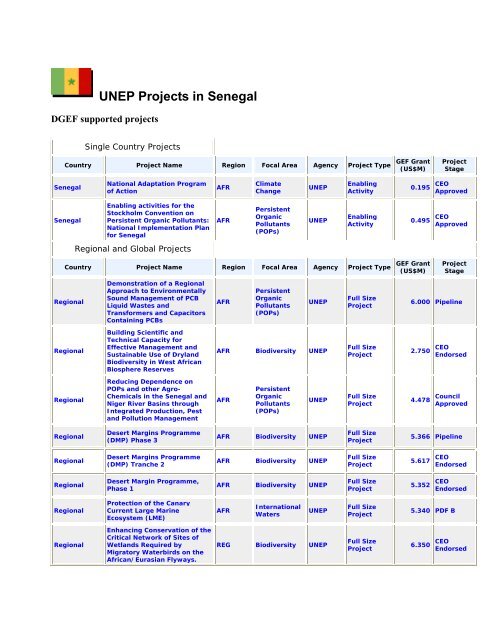
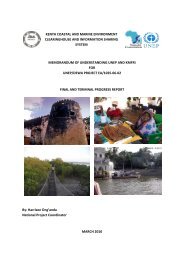
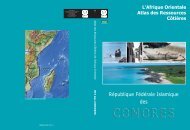

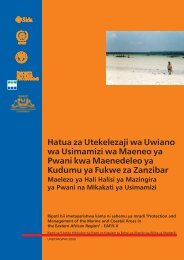
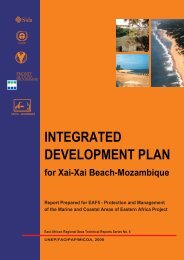
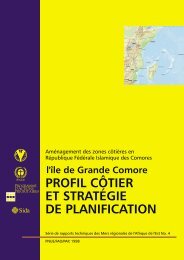

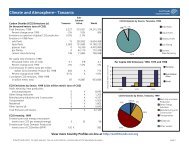

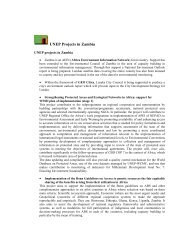
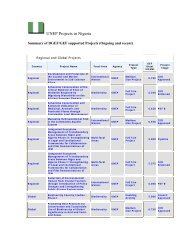
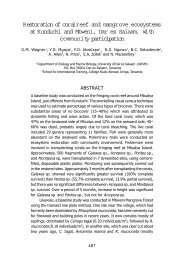
![Please Click to download [English] - GRID Africa GeoPortal - UNEP](https://img.yumpu.com/30633391/1/184x260/please-click-to-download-english-grid-africa-geoportal-unep.jpg?quality=85)
